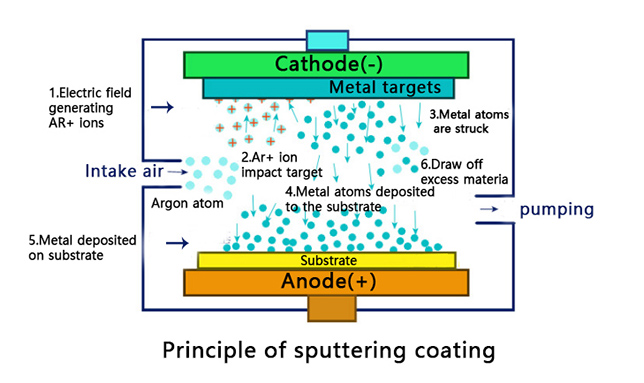1、Features of sputter coating
Compared with conventional vacuum evaporation coating, sputtering coating has the following features:
(1) Any substance can be sputtered, especially high melting point, low vapor pressure elements and compounds. As long as it is a solid, whether it is a metal, semiconductor, insulator, compound and mixture, etc., whether it is a block, granular material can be used as a target material. Since little decomposition and fractionation occurs when sputtering insulating materials and alloys such as oxides, they can be used to prepare thin films and alloy films with uniform components similar to those of the target material, and even superconducting films with complex compositions.´ In addition, the reactive sputtering method can also be used to produce films of compounds completely different from the target material, such as oxides, nitrides, carbides and silicides.
(2) Good adhesion between the sputtered film and the substrate. Since the energy of sputtered atoms is 1-2 orders of magnitude higher than that of evaporated atoms, the energy conversion of high-energy particles deposited on the substrate generates higher thermal energy, which enhances the adhesion of sputtered atoms to the substrate. A portion of the high-energy sputtered atoms will be injected to varying degrees, forming a so-called pseudo-diffusion layer on the substrate where the sputtered atoms and the atoms of the substrate material “miscible” with each other. In addition, during the bombardment of the sputtering particles, the substrate is always cleaned and activated in the plasma zone, which removes the poorly adhered precipitated atoms, purifies and activates the substrate surface. As a result, the adhesion of the sputtered film layer to the substrate is greatly enhanced.
(3) High density of sputter coating, less pinholes, and higher purity of the film layer because there is no crucible contamination, which is unavoidable in vacuum vapor deposition during the sputter coating process.
(4) Good controllability and repeatability of film thickness. Since the discharge current and target current can be controlled separately during sputter coating, the film thickness can be controlled by controlling the target current, thus, the controllability of the film thickness and the reproducibility of the film thickness by multiple sputtering of sputter coating are good, and the film of predetermined thickness can be effectively coated. In addition, sputter coating can obtain a uniform film thickness over a large area. However, for general sputter coating technology (mainly dipole sputtering), the equipment is complicated and requires high pressure device; the film formation speed of sputter deposition is low, the vacuum evaporation deposition rate is 0.1~5nm/min, while the sputtering rate is 0.01~0.5nm/min; the substrate temperature rise is high and vulnerable to impurity gas, etc. However, due to the development of RF sputtering and magnetron sputtering technology, great progress has been obtained in achieving fast sputtering deposition and reducing the substrate temperature. Moreover, in recent years, new sputter coating methods are being investigated – based on planar magnetron sputtering – to minimize the sputtering air pressure until zero-pressure sputtering where the pressure of the intake gas during sputtering will be zero.

Post time: Nov-08-2022

